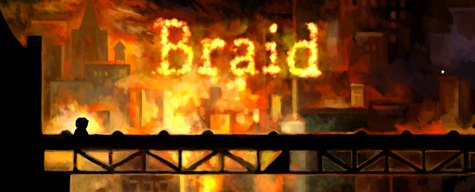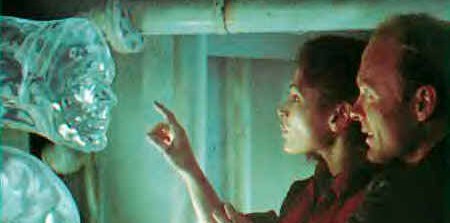or: “what games story can learn from Stephen Moffat”
So Braid finally came out. I was in shock when I saw the release date; wonderful as it was, I was never sure I was going to get a chance to play it. I shouldn’t have worried. It’s out, I’ve got it, and so far, it’s been very, very special.

And it’s had me thinking, because with all the coverage of Braid in the past few weeks – not to mention Jonathan Blow’s excellent keynote at Games:EDU last week – I’ve been thinking about games, and stories, and narrative, and writing (which is a special interest of mine if only because it’s one of the few things I know about that I actually studied). To understand what stories that can only be told in games look like, you need to know what stories that can only be told in other mediums look like. And that was when I realised I had some really good, mainstream examples to hand, and that I should explain this on the internet.
Now, to do that, I’m going to have to talk about Doctor Who.
Stephen Moffat wrote easily the best episode of new Who, Blink (from Season 3), and probably the best episodes of the most recent season – Silence in the Library and Forest of the Dead.
His episodes have received critical praise (ie: praise from adults); at the same time, they haven’t deviated from the core premise of the show: exciting sci-fi adventure aimed at the family market, which is basically 8-12-year-olds. This is a good thing. I’m very much with Mark Kermode when he points out that there’s far too much of an onus right now for entertainment targeting children to have “something for adults too”. If it’s good, it should appeal to everybody.
Stephen Moffat’s episodes are classic family entertainment; at the same time, they demonstrate very clearly that he understands the medium he’s working in – TV – explicitly, and he’s capable of writing stories that can only be told in TV and film.
Moffat’s episodes are designed around mechanics of fear. Specifically, the very things that most children are afraid of, or have been afraid of at some point in their life.
Blink is about creepy statues (which turn out to be aliens) that only move when you’re not looking at them. It taps into a fear of the uncanny, the ancient, and the inexplicable.
Silence in the Library and Forest of the Dead are about many things, but at the core of them is the primal fear of the dark. In it, shadows turn out not to be an effect of light, but creatures – the Vashta Nerada, vast clouds of tiny creatures that eat people.
Who hasn’t been afraid of the dark?
Both are great plot devices. Neither requires much in the way of complex effects. But the most important thing about them – certainly in terms of this article – is that they are plot devices that are entirely native to television and film.
Blink is an entire drama made possible by the fact that whilst TV is a linear medium, the audience understands editing. Editing as an artform has evolved over time; it was developed after the initial invention of film, and it was only a reasonable period after film’s creation that it was understood not only as a technique, but also as an art in its own right. (For a great example, look at the first five minutes of Nic Roeg’s Don’t Look Now – a very important sequence in that film, where it’s important that the editing shows how the characters are perceiving events as much as how they’re happening).
Anyhow, Blink and editing. The audience understands (even implicitly) that the statues aren’t moving in a blink of our eye; they’re moving in a blink of the characters’ eyes. This means they move in that simplest of scary-movie techniques, the jump-cut.
Because this jump-cut takes us by surprise, the creatures scare us like they scare the characters – even if we know that they’re not really moving when we don’t look. This particular kind of delivery of shocks isn’t possible (or at least as effective) in, eg, written fiction, because there is no possibility for edits, for jumpcuts. Prose flows in a linear manner forward, and whilst the writing may contain careful pacing, the act of reading is paced fairly consistantly.

The two-part story in Silence in the Library and Forest of the Dead is a drama all about light and dark. The Vashta Nerada, as mentioned, are clouds of creatures that look exactly like shadows – and are, of course, represented as shadows on screen. There are a few important effects shots where characters are seen to have multiple shadows, but most of the time, there’s no need for trickery.
All the “magic” is in set and lighting design, and script: dark corners, nooks and crannies, and the characters telling us they’re afraid of the dark. When the Doctor says “stay out of the shadows,” he reminds the audience that they too were afraid of the dark once. And, of course, as a child, when you say you’re afraid of the dark, an adult tells you there’s nothing there. The Doctor has told us to be afraid of the dark because the dark really is a monster. He’s contradicted our parents and made us even more afraid. It’s terrifying.
We need to find stories that we can only tell in games. We need to find play mechanics that tell us things about the world.
Both of these stories are natively filmic: a story that can only be told when you understand editing; a story built around the visual representation of light. These are, of course, not the only things the story is about – far from it; their richness and brilliance is the real reason Moffat has been so admired. But it’s important to appreciate that these two storylines stem from an individual technique or aesthetic that’s uniquely represented by the medium (TV/film).
Or, to put it more simply (and I think more effectively):
something everyone is afraid of when they’re eight + a plot device that can be satisfactorily represented on television/film without being too expensive or convoluted.
So what has this got to do with games?
The notion of telling stories appropriate to a medium is one response to what Braid developer Jonathan Blow is getting at in his Games:EDU keynote. Rather than resolving the conflict between ludic and narrative elements by wrapping gameplay around the story, why not write stories that can only be told through gameplay?
Braid is a game about trying to reverse the past; its time-control mechanic is an important commentary on the central character’s predicament. Moffat’s Blink would make a poor videogame, simply because it’s unfair; the Weeping Angels essentially have a cheatcode to the world, and their movement patterns wouldn’t make for fun.

But a game built around shadows – genuine light and dark area – as a foe might work. It’s very gamelike – and it’s that that set me thinking on this whole endeavour. We have spent so much money on lighting technologies and graphics cards and we can now make beautiful light and dark – both realistic and expressive. Why can’t that be a game – or at least, the starting point for a game – in its own right? Just because at the moment it just a neat visual effect doesn’t mean we can’t put it front and centre. This is something that, for a while, James Cameron did very effectively. The Terminator, T2, The Abyss, even Titanic; these are all movies that require sophisticated visual effects to tell a key part of the story – the T-800, the T-1000, the underwater creature, the ship; without convincing, cutting edge effects technology, these movies fall apart. But Cameron is interested primarily in his characters: once he has his core, visual-effect oriented premise in place, he turns his camera to the characters. He wants to tell human stories; he just happens to have found stories about that need remarkable visual effects to play out.
We need to find stories that we can only tell in games. We need to find play mechanics that tell us things about the world. And if we’re stuck for inspiration, it’s worth considering how other mediums have approached this issue. Above, there are a few examples; there are many more, when it comes to literature, and film, and radio drama, and theatre (and especially those last two). But when it comes to games, there aren’t enough.
We need to start considering what they might look like. Stories about shadows and lighting. Stories about physical worlds told through physics engines. Stories about direct control, or the lack of it.
Some of these exist; more need to. That’s the challenge facing games right now. If you’re looking for an example, download Braid and savour it. It really does succeed at the things Blow hints at. It tells a story you need to experience, and you need to experience the mechanic at the core of it to appreciate the game’s message. It’s remarkable.